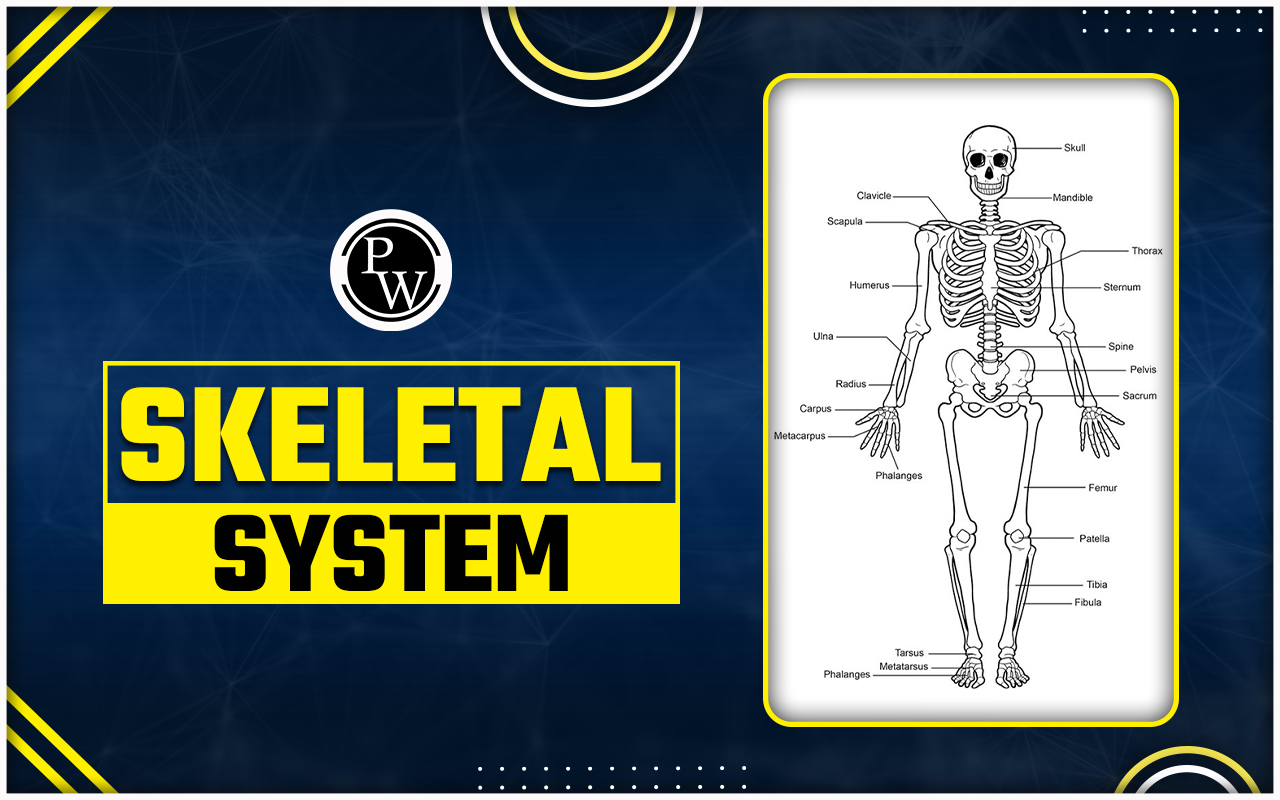

Skeletal System: The skeleton is like your body's framework. It shapes your body, lets you move, produces blood cells, shields your organs, and holds minerals. Another name for the skeleton is the musculoskeletal system.
What Is a Skeletal System?
The human skeleton comprises all the bones, cartilage, tendons, and ligaments in the body. In total, the skeleton makes up approximately 20 percent of a person’s body weight. Adults typically have 206 bones in their skeleton. Children have more bones because some, like those in the skull, fuse together as they grow. Differences exist between the male and female skeletons. The male skeleton is generally longer and has a higher bone mass. In contrast, the female skeleton has a wider pelvis to accommodate pregnancy and childbirth. Irrespective of age or gender, the skeletal system can be divided into axial and appendicular parts.What Are the Main Parts of the Skeletal System?
If you imagine your skeleton, you might remember the fake bones your science teacher had in the class. While it holds all your bones, your skeletal system also includes various other tissues. Your skeletal system consists of:- Bones: The main support for your body comes from bones. Adults possess between 206 and 213 bones.
- Muscles: Composed of tightly woven, stretchy fibres, muscles – numbering over 600 in your body – aid in activities like walking, running, and jumping, as well as essential functions like breathing and digesting food.
- Cartilage: Acting as a robust and flexible tissue, cartilage serves as a shock absorber in various joints throughout your body.
- Ligaments: Tissue bands connecting bones to other bones are known as ligaments.
- Tendons: Cords linking muscles to bones are called tendons.
- Joints: Any point where two bones meet is a joint, which may include some or all of the elements mentioned above.
Axial Skeleton
The adult axial skeleton consists of 80 bones. It’s made up of the bones that form the vertical axis of the body, such as the bones of the head, neck, chest, and spine.Skull bones
The adult skull comprises 22 bones. These bones can be further classified by location:- Cranial bones. TThe main part of your skull is made up of eight cranial bones. They play a role in safeguarding your brain.
- Facial bones. On the front of the skull, there are 14 facial bones that together form the face.
Auditory ossicles
The hearing bones, called auditory ossicles, are six tiny bones located in the inner ear canal of the skull. There are three auditory ossicles on each side of the head, and they are known as:- malleus (hammer)
- incus (anvil)
- stapes (stirrup)
Hyoid
The hyoid is a bone shaped like a U, located at the bottom of the jaw. It works as a spot where muscles and ligaments in the neck attach.Vertebral column
The backbone consists of 26 bones. The initial 24 are vertebrae, and then comes the sacrum and coccyx, also known as the tailbone. The 24 vertebrae can be further divided into the:- Cervical vertebrae. These seven bones are found in the head and neck.
- Thoracic vertebrae. These 12 bones are found in the upper back.
- Lumbar vertebrae. These five bones are found in the lower back.
Thoracic cage
The chest cage consists of the breastbone (sternum) and 12 pairs of ribs. These bones create a protective cage around the organs in the upper body, such as the heart and lungs. Certain ribs connect straight to the sternum, some are linked through cartilage, and there are also ribs without a direct attachment, known as "floating ribs."Appendicular Skeleton
The appendicular skeleton has a sum of 126 bones. It includes the bones forming the arms and legs, along with those connecting them to the axial skeleton.Pectoral girdle
The shoulder region is where the arms connect to the main skeleton. It consists of the collarbone (clavicle) and shoulder blade (scapula). There are two of each of these, one for each arm.Upper limbs
Each arm contains 30 bones, known as the:- Upper Arm Bone: The humerus is the lengthy bone in the upper arm .
- Forearm Bones: The radius is one of the two lengthy bones in the forearm, located on the thumb side. The ulna is the second long bone in the forearm, situated on the pinky finger side.
- Wrist Bones: The carpals are a set of eight bones located in the wrist area.
- Hand Bones: The metacarpals are five bones situated in the middle part of the hand.
- Finger Bones: The phalanges are 14 bones composing the fingers.
Pelvic girdle
The part of the body called the pelvic girdle, often called the hips, is where the legs connect to the main skeleton. It's formed by two hip bones, one for each leg. Each hip bone has three sections, called:- Ilium: The top part of each hip bone.
- Ischium: A curved bone forming the base of each hip bone.
- Pubis: Found in the front part of the hip bone.
Lower limbs
Each leg is composed of 30 bones, known as the:- Femur. The femur is the large bone of the upper leg.
- Tibia. The tibia is the main bone of the lower leg. It forms the shin.
- Fibula. The fibula is the second bone in the lower leg, found in the outer leg.
- Patella. The patella is also called the kneecap.
- Tarsals. The tarsals are the seven bones that make up the ankle.
- Metatarsal. The metatarsals are the five bones that make up the middle area of the foot.
- Phalanges. The phalanges are 14 bones that comprise the toes.
What Are the Functions of the Skeletal System?
The skeletal system is a crucial component of the human body, playing a vital role in providing support, protection, and mobility. Comprising bones, cartilage, ligaments, and tendons, the skeletal system serves various essential functions that contribute to the overall health and functionality of the body. Here are some key aspects highlighting the importance of the skeletal system: Structural Support- The primary function of the skeletal system is to provide structural support to the body. Bones act as a framework that gives the body its shape and form.
- The axial skeleton, including the skull, vertebral column, and ribcage, supports the central axis of the body, while the appendicular skeleton, consisting of the limbs and girdles, facilitates movement and supports the limbs.
- Bones serve as protective shields for vital organs. For instance, the skull protects the brain, the ribcage safeguards the heart and lungs, and the vertebrae shield the spinal cord.
- Without the skeletal system, these delicate and vital structures would be more susceptible to injury and damage.
- The skeletal system provides a framework for muscles to attach, allowing for coordinated movement. Muscles pull on bones, and the joints act as levers, facilitating a wide range of movements from simple tasks like walking to complex activities like playing sports.
- Joint flexibility and mobility are crucial for performing daily activities and maintaining an active lifestyle.
- Within the bone marrow, a soft tissue found in the cavities of bones, blood cells are produced. Red blood cells, white blood cells, and platelets are essential components for the body's immune system, oxygen transport, and blood clotting, respectively.
- Bones act as a reservoir for essential minerals, particularly calcium and phosphorus. These minerals play a vital role in various physiological processes, including muscle contraction, nerve function, and blood clotting.
- When the body requires these minerals for metabolic processes, the skeletal system releases them into the bloodstream.
- The skeletal system contributes to the maintenance of the body's acid-base balance by absorbing or releasing alkaline salts from the bones. This process helps regulate the pH level of bodily fluids.
- Additionally, the skeletal system plays a role in regulating the concentration of calcium in the blood, which is crucial for nerve function and muscle contraction.
- Over the course of a lifetime, the skeletal system undergoes continuous remodelling. Bone tissue is constantly being broken down and rebuilt, which helps maintain the structural integrity of the skeleton.
- Regular weight-bearing activities and a balanced diet contribute to bone health and help prevent conditions like osteoporosis.
What kinds of conditions affect the skeletal system?
Fractures
A breakage is another way to describe a fractured bone. Fractures usually happen because of an injury, like a car crash or a fall. There are various types of fractures, but they are mainly sorted based on how and where the break occurs.Metabolic bone diseases
Diseases affecting bone strength or integrity are called metabolic bone diseases. These can result from things like a lack of vitamin D, bone mass loss, or the use of certain medicines, such as steroids or chemotherapy.Arthritis
Arthritis is joint inflammation, causing pain and limited movement. Arthritis can be triggered by factors like cartilage breakdown in joints, autoimmune conditions, or infections.Cancer
Cancer may form in bone tissues or cells produced by bones. Primary bone tissue cancer is uncommon, while cancers like myeloma or lymphoma, originating from blood cells produced by bones, are more prevalent.Spinal curvatures
A spinal curvature is when the spine doesn’t curve in its usual shape. Typically, the spine follows gentle forward and backward curves. There are three main types of spinal curvature:- Kyphosis. Kyphosis creates a rounding in the upper back.
- Lordosis. Lordosis causes the lower back to curve inward.
- Scoliosis. Scoliosis causes an S- or C-shaped curve in the spine.
Conditions and Disorders
Lots of common health conditions and injuries can affect your skeletal system because it’s such an important part of how you use your body. Anything that damages your bones or connective tissue affects your skeletal system, including:- Arthritis
- Bursitis
- Tendinitis
- Osteoporosis
- Rheumatoid arthritis (RA)
- Psoriatic arthritis
- Lupus
- Sjögren’s syndrome
- Sports injuries
- Bone fractures (broken bones)
- Dislocations
- Muscle strains (pulled muscles)
- Ligament tears and sprains
Common signs or symptoms of skeletal issues
Because so many conditions and injuries can affect your skeletal system, you might experience lots of different symptoms. Some common symptoms include:- Pain (including muscle pain, joint pain, or bone pain)
- Stiffness
- Swelling (inflammation)
- Skin discoloration or bruising
- A feeling of heat or warmth
- Trouble moving a part of your body (a reduced range of motion)
- Hearing or feeling a pop or grinding
Common tests done on the skeletal system
A healthcare provider will suggest tests based on where you’re experiencing pain or other symptoms. You might need:- X-rays
- Ultrasounds
- A computed tomography (CT) scan
- Magnetic resonance imaging (MRI)
- A bone density test (DXA scan)
What are common treatments for the skeletal system?
Your bone structure usually doesn't require attention unless there's a health issue or injury. Your healthcare provider will recommend ways to address the underlying causes of your symptoms and assist your body in recovery. Some usual treatments include:- Medication: Non-prescription drugs such as NSAIDs (nonsteroidal anti-inflammatory drugs) and acetaminophen can ease pain and reduce swelling. Your healthcare provider may recommend corticosteroids or specific medications for treating autoimmune conditions.
- Immobilisation: Following an injury, it's typical to use a brace, splint, sling, or cast. This will keep the injured area stable during your recovery. Your healthcare provider will advise on the type of restraint needed and the duration for wearing it.
- Physical therapy: A physical therapist will assist you in building muscle strength and improving flexibility, especially after an injury.
- Arthroplasty (joint replacement): In certain cases, individuals may require partial or complete joint replacements, with hips and knees being commonly replaced joints. Your healthcare provider or surgeon will provide information on what to anticipate.
Tips for a Healthy Skeletal System
The skeletal system provides the foundation for all of the body’s movements, in addition to other important functions. Follow these tips to keep it in good working order:- Consume calcium. Calcium-rich foods include leafy green vegetables, broccoli, tofu, and fish such as salmon.
- Get enough vitamin D. Most people get plenty of this by spending regular time outdoors, but a vitamin D supplement can help those in areas that don’t get much sunlight.
- Do weight-bearing exercises. These include things like walking, jogging, and climbing stairs.
- Wear protection. Always wear protective gear when riding a bike or playing contact sports to avoid bone fractures and other potentially serious injuries.
Skeletal System FAQs
Can you increase bone density?
Weight-bearing exercises, a diet rich in calcium and vitamin D, and avoiding smoking and excessive alcohol consumption can contribute to increased bone density.
At what age do bones stop growing?
Bones typically stop growing in length during the late teens to early twenties, but bone density continues to change throughout life.
How does ageing affect the skeletal system?
Aging can lead to a decrease in bone density, and joint flexibility, and an increased risk of conditions such as osteoporosis and arthritis.
What is the role of calcium in bone health?
Calcium is essential for bone strength and density. It is a key mineral incorporated into the bone matrix, contributing to overall skeletal health.
Can you live without a particular bone?
While some bones are more crucial than others, the human body generally requires the entire skeletal structure for proper support, protection, and movement.
🔥 Trending Blogs
Talk to a counsellorHave doubts? Our support team will be happy to assist you!

Check out these Related Articles
Free Learning Resources
PW Books
Notes (Class 10-12)
PW Study Materials
Notes (Class 6-9)
Ncert Solutions
Govt Exams
Class 6th to 12th Online Courses
Govt Job Exams Courses
UPSC Coaching
Defence Exam Coaching
Gate Exam Coaching
Other Exams
Know about Physics Wallah
Physics Wallah is an Indian edtech platform that provides accessible & comprehensive learning experiences to students from Class 6th to postgraduate level. We also provide extensive NCERT solutions, sample paper, NEET, JEE Mains, BITSAT previous year papers & more such resources to students. Physics Wallah also caters to over 3.5 million registered students and over 78 lakh+ Youtube subscribers with 4.8 rating on its app.
We Stand Out because
We provide students with intensive courses with India’s qualified & experienced faculties & mentors. PW strives to make the learning experience comprehensive and accessible for students of all sections of society. We believe in empowering every single student who couldn't dream of a good career in engineering and medical field earlier.
Our Key Focus Areas
Physics Wallah's main focus is to make the learning experience as economical as possible for all students. With our affordable courses like Lakshya, Udaan and Arjuna and many others, we have been able to provide a platform for lakhs of aspirants. From providing Chemistry, Maths, Physics formula to giving e-books of eminent authors like RD Sharma, RS Aggarwal and Lakhmir Singh, PW focuses on every single student's need for preparation.
What Makes Us Different
Physics Wallah strives to develop a comprehensive pedagogical structure for students, where they get a state-of-the-art learning experience with study material and resources. Apart from catering students preparing for JEE Mains and NEET, PW also provides study material for each state board like Uttar Pradesh, Bihar, and others
Copyright © 2025 Physicswallah Limited All rights reserved.
Get App











